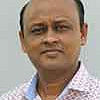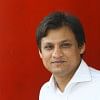Hefajat : Then and now
(Drag the middle bar from left to right to see full photos) THEN: Police, in riot gear, fire tear gas shells on Hefajat-e Islam members and activists at Shapla Chattar in Dhaka on May 6, 2013. They had occupied the area for a rally and then refused to leave hours after it had ended. Photo: Star. NOW Hefajat-e Islam members and activists gather at rally organised by Al-Hiyatul Ulya Lil-Zami'atil Qawmiya Bangladesh, a combine of Qawmi education boards led by Hefajat chief Shah Ahmed Shafi, at Suhrawardy Udyan in Dhaka on Sunday, November 4, 20a18. Photo: BSS
As Hefajat-e Islam activists turned increasingly violent and kept Motijheel occupied for nearly 12 hours after their rally there on May 5, 2013, the law enforcers swung into action after midnight and drove them away.
The capital's Paltan and Motijheel areas transformed into a scene of mayhem as unruly Hefajat men burned down and vandalised properties and clashed with law enforcers. At least 39 people were killed in the violence.
At least 83 cases were filed later accusing 3,416. Many senior Hefajat leaders went into hiding fearing arrests.
Following that show of strength in the capital, the Hefajat did not have to take to the streets again as the Islamist group got much of whatever it wanted through negotiations that took place away from the public eye.
Five years down the line, they held a rally in the capital yesterday in cooperation with the government under the banner of Al-Hiyatul Ulya Lil-Zami'atil Qawmiya Bangladesh, a combine of Qawmi education boards led by Hefajat chief Shah Shafi Ahmed.
The event was organised to applaud the passing of a bill recognising the Dawra-e-Hadith degree as an equivalent of master's in Islamic studies and Arabic. This time, Prime Minister Sheikh Hasina addressed the rally as the chief guest.
Shafi thanked the prime minister for the law and demanded that the government withdrew the cases filed in 2013.
The situation was different five years ago.
The Hefajat was given the permission to hold a peaceful rally to press home its 13-point demand.
But the situation went out of hand around 3:00pm when, according to media reports, top opposition leaders managed to persuade Shafi to ask the activists not to leave the capital.
The BNP-led alliance, which was agitating at the time for restoration of the polls time government, extended its support to the Hefajat.
Shafi, who refrained from joining the afternoon rally, issued a statement late at night announcing that a peaceful sit-in would continue in Motijheel until the government met their demands.
Thousands of Hefajat men then refused to leave the area.
The situation started worsening as the day progressed. Parts of downtown Dhaka were burnt and ravaged. Thousands of Hefajat men, instigated and bolstered by Jamaat-Shibir activists, set fire to hundreds of shops and police outposts as the evening descended. Dhaka skyline turned orange, as flames leapt high and the power supply was cut off. The country has seldom experienced brute violence on this scale.
Syed Ashraful Islam, then AL general secretary and LGRD minister, at a press conference in the afternoon said Hefajat men must leave the capital peacefully by the evening.
“The so-called Hefajat has unleashed a reign of terror by torching and vandalising political party offices, vehicles and public properties. The government is ready to take any action to maintain law and order,” he said.
The BNP, Jamaat and Hefajat are "one and the same" and a large number of BNP and Jamaat men have joined the Hefajat programme, he said.
The Hefajat first appeared on the scene in 2009 by protesting a draft national women development policy that provided equal inheritance rights to women.
A year later, it demanded cancellation of a proposed national education policy that focused on secular curriculum for schools and colleges.
In 2013, Hefajat, headquartered in Darul Uloom Moinul Islam Madrasa in Chittagong's Hathazari, became the main force opposing the Shahbagh Gonojagoron Mancha.
Bloggers and online activists spearheaded the popular Shahbagh movement and formed the Gonojagoron Mancha, demanding death penalty for war criminal Abdul Quader Mollah.
After the February 15 killing of Rajib, a blogger who was branded an atheist, Hefajat began to allege that some of the Shahbagh activists' blog posts offended the “Muslim's religious feelings”.
On April 6, Hefajat men marched towards Dhaka and held a rally at Shapla Chattar with their 13-point demand, including enactment of anti-blasphemy act and stringent punishment of “atheist bloggers”.
A good relation has been developed between the government and Hefajat following the Shapla Chattar mayhem. Hefajat had since remained almost quiet about its 13-point demand.
On multiple occasions, several central Hefajat leaders said the government had convinced them to refrain from taking to the streets.
Hefajat no longer criticises the government for what it earlier said was a “brutal action against their activists” at Shapla Chattar.
The Islamist group had once claimed that the government carried out "genocide by killing thousands of its men on May 5 and in the early hours of May 6”.
Meanwhile, the cases filed against Hefajat men in 2013 have been stalled.
On several occasions, Hefajat leaders said they were not worried about the cases as they had an “understanding” with the government.
The group's two big achievements last year were the major changes in school textbooks brought reportedly in line with its recommendations and the recognition of a Qawmi degree.
Addressing a meeting of Alem and Ulema of Qawmi madrasas at the Gono Bhaban on April 11, Hasina said she did not like the statue of Greek Goddess Themis on the Supreme Court premises.
The prime minister's support for Hefajat's demand for removal of the statue and the government's shelving of plans to reform Qawmi madrasa education made the group happy.
Finally, they returned to the capital yesterday and their chief said Hasina's name would be written in golden letters in history for the recognition of the Dawra degree.


 For all latest news, follow The Daily Star's Google News channel.
For all latest news, follow The Daily Star's Google News channel. 







Comments